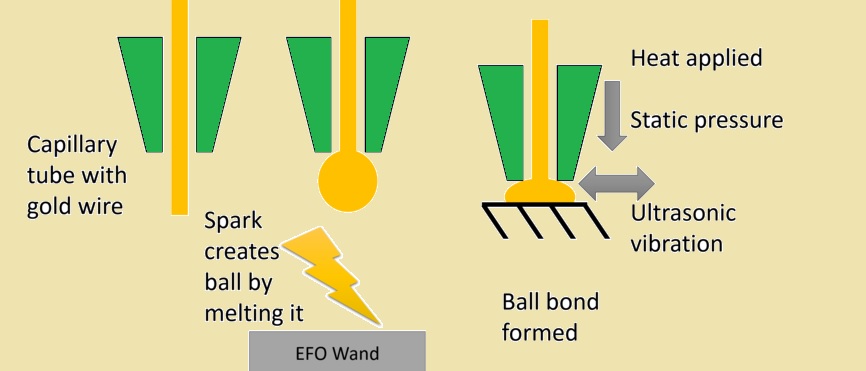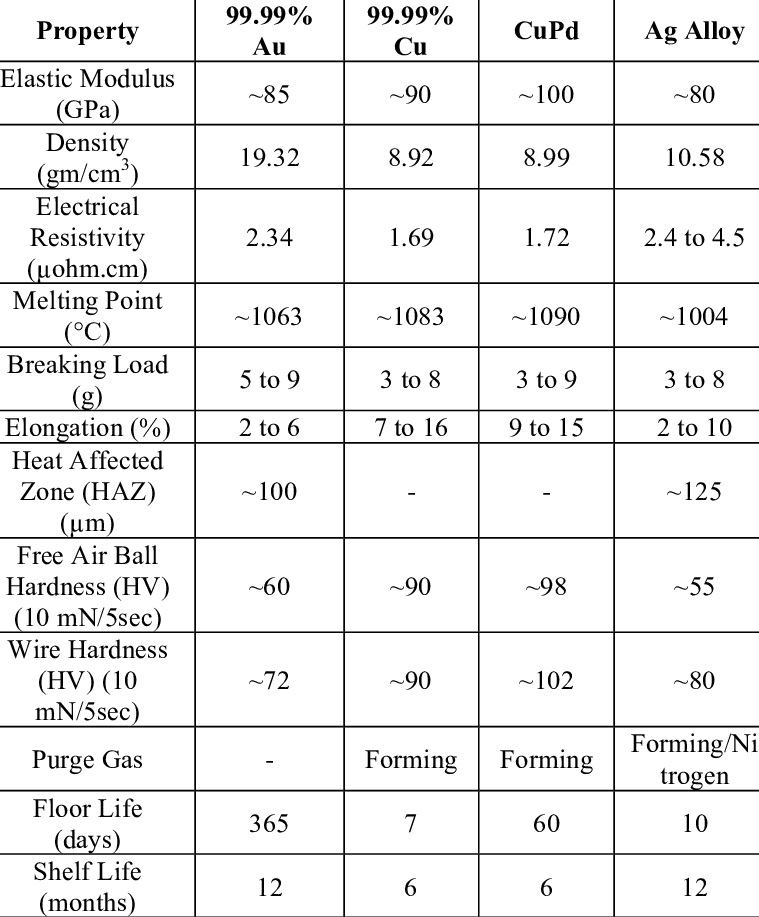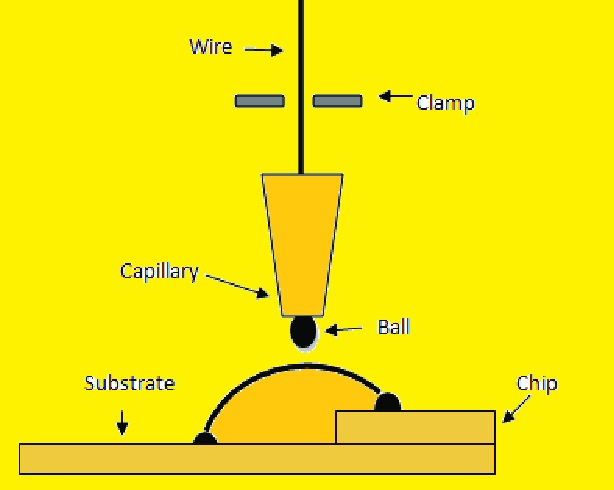Hello readers, welcome to the new post. Here, we will learn wire bonding processes and advanced PCB design. Wire bonding is a helpful feature of electronics manufacturing and board design. In this post, we will discuss the details of wire bonding, its process, and its common uses in advanced PCB design. So let’s get started with What Wire Bonding.
Introduction
The wire bonding process is used to make electrical interconnections between a semiconductor or integrated circuit and silicon chips with the use of bonding wires that are made with gold and aluminum.
Two commonly used processes for wire bonding are gold ball bonding and aluminum wedge bonding.
Gold wire bonding is done through thermosonic bonding. It comes with the melting endpoint of the wire to make a gold ball that is known as a free air ball.
The diameter of free air balls is 1.5 to 2.5 times that of wire. After creation, the free air ball is configured in connection with a bond pad, and pressure, heat, and ultrasonic forces are provided for some time.
As a result, metallurgical weld between the ball and the bond pad also helps the deformation of the ball bond in the ending shape.
The commonly used machines for wire bonding are the ASM Eagle 60 Wire Bonder, ASM Eagle 589 Wire Bonder, ASM AB339 Eagle, and Manual Wedge Wire Bonder MDB-2575, and some accurate wire bonding tools are used, like capillary and wire clamps.

What Are the Types of Wire Bonders?
Thermocompression Wire Bonding
Thermocompression bonding is called semiconductor manufacturing as thermocompression welding. It is performed with the use of controlled time, heat, and forces to reshape wire and make accurate bonds.
Pressure, time, and temperature are the main factors in this process. This type of bonding needed a high temperature of more than 300 degrees, high pressure, and a long bonding time to have accurate bonding results.
Due to high diffusion rates, copper, gold, and aluminum are used in this type of bonding wire.
Ultrasonic Wire Bonding:
In this bonding process, ultrasonic energy is used, then heat is applied to make a bond. This process works at low temperatures. In this process, thread wire in a hole in the wedge and trailing in the bonding point. The clamp is used to hold the bonding device placed over the first bond. The wire is pressured between the wedge and bond pad when the wedge is low.
The force of ultrasonic energy is given with the interface of compressive stress; the result of pressure and vibration energy breaks surface oxides and makes a bond.
Thermosonic Wire Bonding
This type of bonding is done with the use of ultrasonic energy, pressure, and heat to connect the wire with a substrate of the surface. In this technique, the capillary is not heated, and the temperature of the substrate is about 100 to 150 degrees.
The ultrasonic energy makes a bond. The diameter of fine wire is about 3 mils, so capillary can effectively deform wire for easy separation. At another point, the capillary makes a circular shape design called a crescent bond. The ball-to-ball wire bonding is used in the thermosonic bonding process.
Limitations of Wire Bond Machines
- In the automotive industry, wire bonders connect busbars of EV battery packs, cells, and modules. This technique causes bottlenecks and fills shop floors with different automatic wire bonders. That increases cost and floor space needs.
Alternative technologies for wire bonding
Laser winding is becoming common for high-speed wire bonding and high-volume production lines.
For the battery production line, a larger number of wire bonders is required to handle the production pace since each battery pack and module needs a larger number of interconnections.
For making high-power connections, there are thin wires used for single connections since the wire has a limited size.
Laser welding machines are more effective than wire bonders due to the absence of mechanical parameters.
The single laser welding machine can be replaced with many wire-bonding machines.
Surface Cleaning Difficulties Before Wire Bonding
For good bonding, the surface is cleaned before bonding of wire. Contaminants such as oxides, grease, and dust must be cleaned. It is important for quality projects like EV batteries.
But for an accurate cleaning process, it is not accurately known which technique has to be used, either laser or plasma cleaning.
Plasma cleaning is not considered as accurate for wire bonding as laser bonding. Plasma cleaning cleans a large part of the surface but slows the cleaning process.
So a high-power system is needed to clean dust particles.
Materials used for wire bonding

Aluminum, silver, gold, and copper are commonly used materials for wire bonding. Gold is mostly used for the ball bonding process, but the introduction of palladium-coated copper wire has made changes in the process of bonding wire.
Currently, PCC wire is very commonly used for wire bonding. In current years, silver wire is used in different packages in place of gold wire.
Aluminum wire used for wedge bonding for power semiconductors
How does wire bonding work?
- Ball bonding
- Wedge bonding
- Compliant bonding
Ball bonding normally uses gold and copper wire and needs heat. For wedge bonding, just gold wire is needed for heat.
Wedge bonding can use larger diameter wires in projects of power electronics. Ball bonding is limited to small-diameter wires that are best for interconnections.
In any type of wire bonding, wire is connected at both ends with the use of downward pressure, ultrasonic, and, in some conditions, heat to make the weld.
Heat is used to make metallic solder. The accurate combination of temperature and ultrasonic energy is used to increase reliability and wire bond strength.
If heat and ultrasonic energy are used, a process called thermionic bonding is used.
For wedge bonding, wire must be put in a straight line according to bonding. It is a slow process due to the time taken for alignment.
Ball bonding makes the first bond in a ball shape with a wire sticking at the upper part, with no directional feature. So wire can connect in any direction and make it a high-speed process.
Read also:
- HOW MANY AMPS CAN 2 AWG WIRE HANDLE?
- Lead vs. Lead-Free Solder in PCB Manufacturing – 2024 Ultimate Guide
- 12 Best Soldering Flux for Electronics 2023 Buying Guide
- 10 Best Soldering Helping Hands Reviews and Buying Guide 2024
- What is a Cold Solder Joint and How Can You Prevent it?
FAQS
What wire is used for wire bonding?
- Wire bonding uses thin metallic bond wires that are made with gold, aluminum, and copper and are thermally or ultrasonically connected with terminal chips on one end and packages.
What is wire bonding in PCB?
- Wire bonding is a technique where an electrical connection between pads and chip substrates is made through the use of micro-welding of micro-wires.
Why is gold used for wire bonding?
- Gold wire bonding is used in LEDs as the gold wire can bond easily through heat, pressure, and ultrasonic energy, which is called thermosonic bonding. With that, the junction size, bond strength, and electrical and thermal conductivity of gold wire are best for LED applications.
What is the temperature of wire bonding?
- Gold wire bonding to an aluminum bond pad is commonly used. Au-Al metallurgy is best and uses about 150°C IC junction temperature. For high silicon junction temperatures of 175°C, Au-Al intermetallics creations limit IC operation to about 1000 hours.
What is the pressure for wire bonding?
- The pressure for wire bonding is normally in the range of 10-20 grams per square millimeter.
What is the average temperature of the wire?
- The materials of the wire and environmental conditions affect the temperature of the wire. that is normally 300 to 500°C is used as temperature
Wire bonding Operating TemperatureThermocompression 300-500°C Ultrasonic 25°C Thermosonic 100-240°C What is the highest temperature wire?
- The materials of the wire and environmental conditions affect the temperature of the wire. that is normally 300 to 500°C is used as temperature
- Tin-plated copper: 180ºC.
- Nickel-plated copper: 450ºC.
- Nickel wire: 450ºC.
What is the maximum temperature for cable?
- The high-rated operating temperature of the cable conductor is about 90 degrees.
- The overload temperature is about 130 degrees, and the short circuit temperature can be 250°C.
Why does temperature increase in a wire?
- The temperature of metallic wire increases when current passes through it; when electrons move from a high energy level to a lower energy level, heat is produced.
What is the resistance of a wire?
- The resistance of wire is directly proportional to length and inversely proportional to cross-sectional area. Resistance value based on conductor material. Resistance increases with temperature increase.
How do you control the temperature of a wire?
- The temperature of the wire must be constant. If current passes through the conductor, a heating effect exists. Electrical energy is transformed into heat energy. To make sure the temperature of the wire does not increase, keep current as low as possible.
What depends on the temperature of the wire?
- Two-factor resistance and conductivity based on temperature. It also affects strength and flexibility.
What is the wire bonding method?
- The two most common methods are gold ball bonding and aluminum wedge bonding.
What is the wire bonding of cells?
Wire bonding is an interconnect method used to bond ICs, semiconductors, and other electronic devices. The process used through high-quality batteries for the production of lithium-ion battery pack assembly
What is wire bonding of semiconductor devices?
Wire bonding is an important interconnection technique that helps reliable transfer of electrical signals and power between different components in semiconductor devices.
